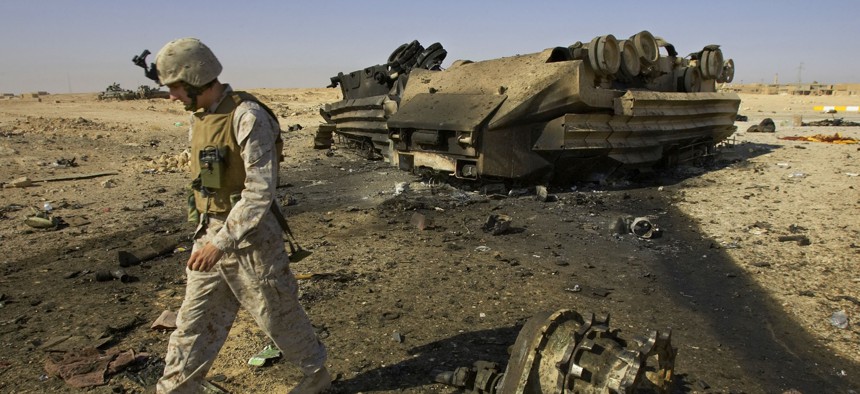
This vehicle was destroyed by a roadside bomb that killed 14 Marines and a civilian interpreter in Barwana, near Haditha, Iraq was the Iraq War's deadliest IED strike at that time. Aug. 4, 2005. AP Photo/Jacob Silberberg
Military Revises Count, Says 500 Americans Likely Killed in Iraq By ‘Iranian Activities’
CENTCOM says that 500 number Sen. Ted Cruz keeps using is accurate—sort of.
The U.S. military has revised its accounting of the number of American troop deaths during the Iraq War it blames on Iran, complicating what had become a talking point for critics of President Barack Obama’s nuclear deal with the regime in Tehran.
U.S. officials revealed on Tuesday that 196 American troops were killed during the Iraq War by Iranian explosively formed penetrators — a particularly deadly form of roadside bomb. That figure is lower than the 500 deaths that Republican lawmakers have said were casualties of the powerful weapon. A recently declassified U.S. Central Command, or CENTCOM, document obtained by Defense One revealed the 196 number and was the first comprehensive accounting of the number of casualties directly linked to the Iranian IEDs.
On Thursday, CENTCOM offered a new conclusion: the 500 number isn’t wrong either, since more than 300 troops were killed by other types of “Iranian activities.” The data pertaining to those deaths is classified, a CENTCOM spokeswoman said.
Many of those additional deaths likely were caused by improvised rocket assisted munitions, described in one Joint IED Defeat Organization document as “a rocket-fired improvised explosive device made from a large metal canister — such as a propane gas tank — filled with explosives, scrap metal and ball bearings and propelled by rockets.”
First seen in Iraq in 2007, the IRAM — “essentially an airborne version of a roadside bomb — a flying IED” is ”the signature weapon used by Iranian-backed militias that operate with the aid of Iran’s Islamic Revolutionary Guards Group,” the undated document says.




